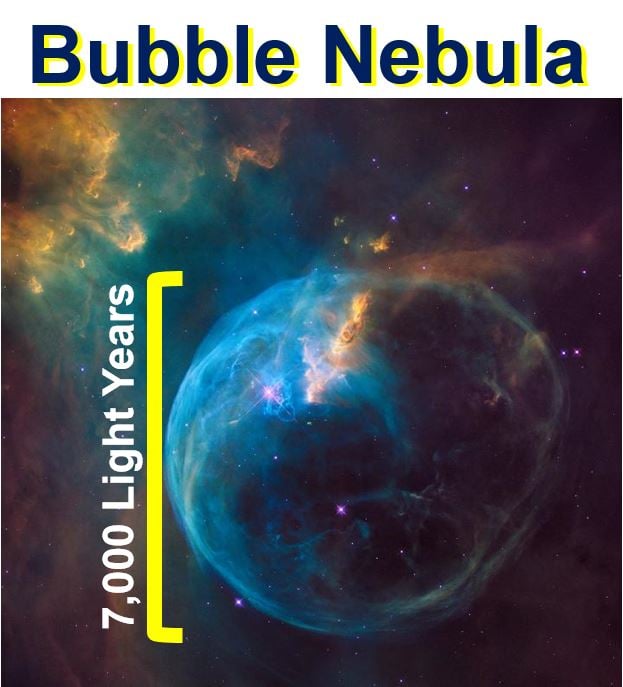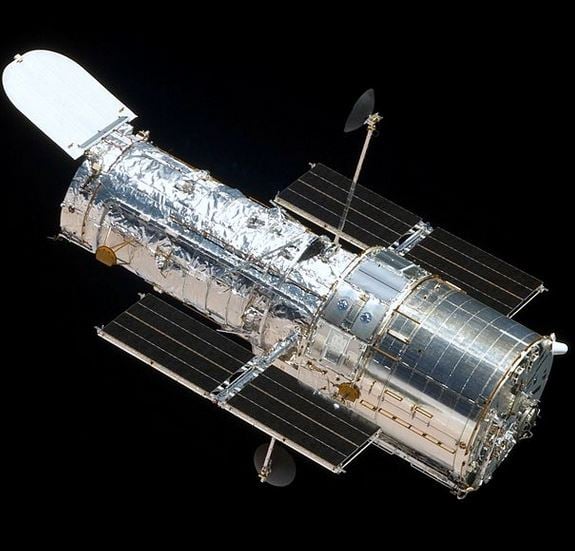The Hubble Space Telescope has captured an image of a giant, super-hot star that has inflated a massive cosmic soap bubble – the Bubble Nebula – into a space balloon seven light years across, making it wider than our Sun’s distance to its nearest neighbouring star.
NASA’s Hubble Space Telescope celebrated its 26th birthday with this spectacular picture. Space scientists chose the Hubble image of the Bubble Nebula, which also has the less romantic name of NGC 7635.
 This is a Hubble Space Telescope image of an gigantic balloon-like bubble being blown into space by an ultra-hot, massive star. Astronomers trained the iconic telescope on this colorful feature, called the Bubble Nebula, or NGC 7635. (Image: NASA)
This is a Hubble Space Telescope image of an gigantic balloon-like bubble being blown into space by an ultra-hot, massive star. Astronomers trained the iconic telescope on this colorful feature, called the Bubble Nebula, or NGC 7635. (Image: NASA)
John Grunsfeld, Hubble astronaut and associate administrator of NASA’s Science Mission Directorate at NASA Headquarters, in Washington, D.C., said:
“As Hubble makes its 26th revolution around our home star, the sun, we celebrate the event with a spectacular image of a dynamic and exciting interaction of a young star with its environment.”
“The view of the Bubble Nebula, crafted from WFC-3 images, reminds us that Hubble gives us a front row seat to the awe inspiring Universe we live in.”
Imagine a bubble 7.5 light-years wide
With a width of seven light years, the Bubble Nebular is approximately 1.5 times the distance from the Sun to Alpha Centauri, its nearest stellar neighbour. Referred by many as the cosmic soap bubble, the Bubble Nebula resides in the constellation Cassiopeia, 7,100 light years from Earth.
The simmering star that is forming this nebula is huge – about forty-five times more massive than our Sun. This star’s gas gets so hot that it escapes into space as a fast-moving ‘stellar wind’, travelling at more than 4 million miles per hour (6.47 million k/ph).
 According to hubblesite.org: “Hubble is one of NASA’s most successful and long-lasting science missions. It has beamed hundreds of thousands of images back to Earth, shedding light on many of the great mysteries of astronomy. Its gaze has helped determine the age of the universe, the identity of quasars, and the existence of dark energy.” (Image: Wikipedia)
According to hubblesite.org: “Hubble is one of NASA’s most successful and long-lasting science missions. It has beamed hundreds of thousands of images back to Earth, shedding light on many of the great mysteries of astronomy. Its gaze has helped determine the age of the universe, the identity of quasars, and the existence of dark energy.” (Image: Wikipedia)
This blast of super-hot gas sweeps up the cold, interstellar gas in front of it, piling up to form the outer edge of the bubble, similar to how a snowplow piles up the snow as it pushes it forward.
As the surface of the shell of this massive bubble expands outwards, it crashes into the dense regions of much colder gas on one side of the bubble. This asymmetry makes the star appear well away from the centre, with its location on the ten ‘clock position in Hubble’s image.
Dense columns of cold hydrogen gas sprinkled with dust appear at the upper-left of the image, and more ‘fingers’ are visible nearly face-on, behind the semi-transparent bubble.
Colours reflect different temperatures
The different gases, at varying temperatures, emit a range of colours. For example, oxygen is so hot it appears in blue in the bubble near the star. The cooler nitrogen and hydrogen in the pillars are yellow.
Scientists from the NASA/Goddard Space Flight Center said the pillars look like the iconic columns in the ‘Pillars of Creation’ Eagle Nebula.
The Bubble Nebula pillars are illuminated by the strong ultraviolet radiation from the brilliant star within the bubble, as seen with the structures in the Eagle Nebula.
We have known about the Bubble Nebula for hundreds of year. It was discovered by Frederick William Herschel (1738-1822), a British astronomer and composer of German origin in 1787.
The Bubble Nebula is being formed by an O star – BD +60º2522 – an incredibly-bright, massive star with a relatively short life span that has lost most of its outer hydrogen and is currently fusing helium into heavier elements.
A young star that ends in a supernova explosion
The star is very young – only about four million years old. Astronomers say it will probably explode as a supernova in ten to twenty million years’ time.
The Hubble Space Telescope’s Wide Field Camera 3 captured the nebula in visible light with extraordinary clarity last February. The colours correspond to the red for nitrogen, green for hydrogen and blue for oxygen.
This information will help scientists gain a better understanding of the dynamics and geometry of this complex system.
The Bubble Nebula is one of just a few celestial objects that have been observed with a number of different instruments onboard Hubble.
It was also imaged with Hubble’s WFPC (Wide Field Planetary Camera 24 years ago (Sept 1992), and with WFTC2 (Wide Field Planetary Camera 2) in April, 1999.
Video – Hubble sees star ‘inflating’ a giant bubble
This NASA video zooms into the Hubble Space Telescope image of a massive, balloon-like bubble being blown into space by a huge, seething star.
